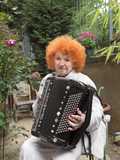Yvette Horner / Paris
Play it again
French accordion player Yvette Horner harks back to another age. Hers is a nostalgic repertoire that draws on the countryside as a source of inspiration. Yet despite the years, her shock of orange hair and desire to play remain.

In Yvette Horner’s living room in Paris, there is no doubt which instrument made her famous. There’s a giant accordion-shaped mirror, matching accordion candelabras, a wooden credenza inlaid with accordions and framed pictures showing her playing the accordion. At 89, Horner is a bit frail and needs help hoisting the instrument onto her lap. She’s sold her big house and much of the memorabilia from her music career, and moved into this small assisted-living apartment in eastern Paris.
Despite the setting, Horner isn’t retired. She still has her trademark shock of electric-orange hair, and has nearly completed a new album. Horner easily summons the energy to refute those who would claim that the accordion isn’t a serious instrument. “I love the accordion enormously,” she swoons, mentioning that she’s performed Mozart, Chopin and Liszt on it. “One must not forget the accordion is music.”
Although Horner is barely known outside France, within the country she is legendary. Despite forays into classical music, she is associated with a style called musette. It’s festive, folksy music that takes some beats from waltz and tango and had its heyday in French dance halls in the 1940s and 1950s.
Horner’s image is seeped in nostalgia. For the French, musette is a soundtrack for la France profonde – the provincial, possibly mythical heartland where men wear berets and mothers still make cassoulet for dinner. French people don’t actually want to live in la France profonde anymore. Whole villages are now populated by French geriatrics, alongside British and Dutch holiday home owners. But France’s emotional connection to the countryside lingers. Frenchmen who were born and raised in Paris still claim to be from the little town in Burgundy where their grandparents lived. Horner, though, is a genuine product of la France profonde, born in the small southwestern city of Tarbes in 1922, the only child of ambitious middle-class parents who encouraged her love of the piano. By the age of nine, Horner (then Hornère) was a rising classical pianist at the prestigious Conservatoire de Toulouse.
But Horner’s mother decided that a female accordionist would be more of a novelty than a female pianist. She ordered Yvette to switch instruments. “I wasn’t in charge; my mother was,” Horner recalls. It took three years for her to take any pleasure from the accordion’s windy, mechanical sound. Nevertheless, as a teenager she took first prize at the Concours International d’Accordéonistes.
Horner’s mother, though strict, turned out to be a marketing genius. The petite girl in dainty dresses and bobbed black hair, compressing and elongating the enormous instrument, was soon in demand at cabarets and bals, popular neighbourhood dances that showcased musette. Soon Horner was being offered recording contracts and receiving a congratulatory telegram from Maurice Chevalier. As her success grew, so did Horner’s affection for the instrument.
What made Horner into “notre dame de l’accordéon” were her appearances at the Tour de France. From 1952 to 1964, she performed from the roof of a car in the Tour’s publicity caravan. After the bikes zipped past, fans stayed to watch Horner play and she would appear every day of the three-week race, playing for hours at a time.
The Tour wasn’t just a bicycle race. It was the most followed sporting event in France and a celebration of rural life. Each town the riders crossed showcased its homegrown cheeses, sausages and pretty girls. Horner, wearing a sombrero and playing exuberant musette, became synonymous with the whole event.
By the 1960s, the music was being edged out by rock’n’roll and the “generation of ’68” was demanding that France become a modern, secular, egalitarian country. La France profonde suddenly seemed backward and dated. Horner managed to stay relevant: she dyed her curly hair electric orange and tapped into her classical training. “You can play everything on the accordion,” she says.
The 1990s brought a wave of nostalgia for the old-world culture that the generation of ’68 had discarded. Trendy Parisians began trekking to bals in working-class neighbourhoods and gay discos devoted entire evenings to musette. Jean-Paul Gaultier dressed Horner in a gold-lamé bodysuit and a French flag tutu for a show at the Casino de Paris. And in 1996, François Mitterrand awarded her the Legión d’Honneur.
Horner clearly isn’t part of the new globalised France. During a political debate on French television earlier this year, the far-right politician Marine Le Pen told her opponent, “You’re sort of the Yvette Horner of politics, all the battles you fight are 30 years too late.”
Yet Horner needn’t worry that she’ll be forgotten. After Le Pen’s remarks, sympathetic journalists rushed to Horner’s home to interview her so that she could rebut the attack. Yvette Horner is indeed a throwback to another era. But it’s an era that the French want to remember.
Yvette Horner's CV
1922 Born in Tarbes, Hautes-Pyrénées, France
1952 Starts performing at the Tour de France bicycle race
1989 Horner plays next to the National Jazz Orchestra (conducted by Quincy Jones) to celebrate France’s bicentenary
1996 Awarded the Legión d’Honneurby François Mitterrand
1998 Styled by Jean-Paul Gaultier, Horner is invited to participate in Maurice Béjart’s remake of the ‘Casse-Noisette’ (‘The Nutcracker’) ballet
2005 Horner’s autobiography, ‘Le Biscuit dans la Poche’, is published
2011 Horner’s new album ‘Hors Norme’ (a duet with fellow accordionist Richard Galliano) is completed


